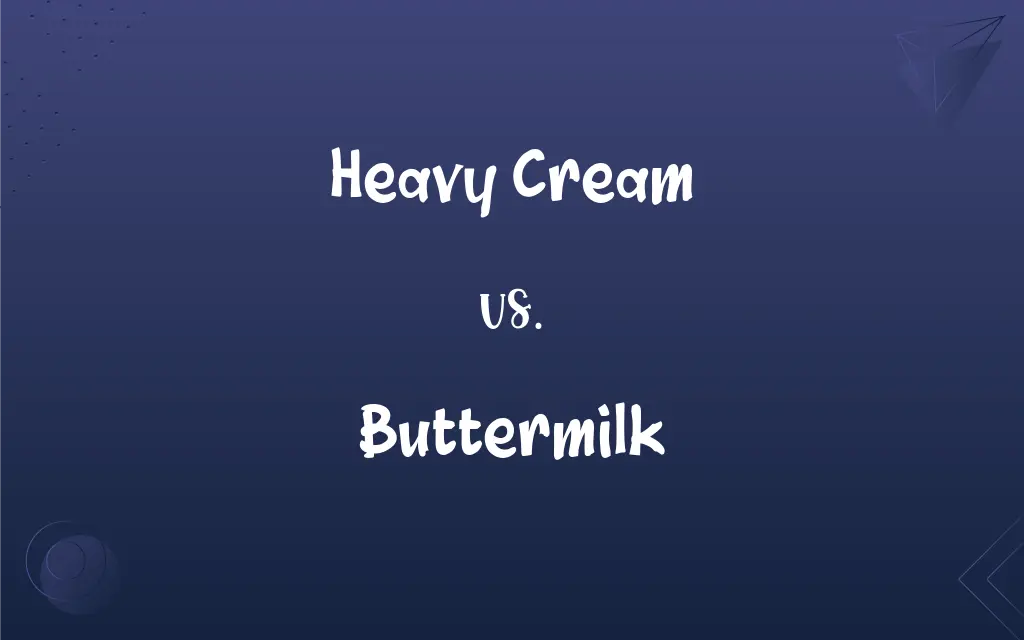Heavy Cream vs. Buttermilk: What's the Difference?
Edited by Harlon Moss || By Janet White || Published on October 23, 2023
Heavy cream is a thick, high-fat cream, while buttermilk is the tangy liquid left after churning butter.

Key Differences
Heavy cream, often just referred to as cream, is a dairy product that has a high-fat content, typically ranging from 36% to 40%. Buttermilk, on the other hand, originally referred to the liquid left after churning butter, which had a slightly sour taste.
In its production, heavy cream is obtained from the high-fat part of fresh milk. It is rich and can be whipped to create whipped cream. Buttermilk today, especially in commercial production, is often cultured milk, meaning it's created by adding lactic acid bacteria to low-fat milk or skim milk.
From a culinary perspective, heavy cream is often used in desserts, sauces, and soups due to its rich texture and flavor. Buttermilk is prized for its tangy flavor, and it's frequently used in baked goods, pancakes, and dressings.
When it comes to consistency, heavy cream is, as the name suggests, heavy and thick. Buttermilk has a thinner consistency, similar to that of regular milk but with a tangy flavor profile.
Nutritionally, heavy cream is calorically dense due to its high fat content. Buttermilk, while lower in fat since it's derived from the butter-churning process or made from low-fat milk, has a unique tanginess due to its acidic nature.
ADVERTISEMENT
Comparison Chart
Source
High-fat part of fresh milk
Liquid from butter-churning or cultured milk
Fat Content
High (36%-40%)
Low
Texture/Consistency
Thick and rich
Thinner, similar to milk
Taste
Creamy
Tangy
Primary Use in Cooking
Desserts, sauces, soups
Baked goods, pancakes, dressings
ADVERTISEMENT
Heavy Cream and Buttermilk Definitions
Heavy Cream
The thickest form of fresh milk with a fat content between 36% to 40%.
For the dessert, she whipped the heavy cream until soft peaks formed.
Buttermilk
A tangy milk product produced by fermenting low-fat milk with lactic acid bacteria.
These days, most buttermilk in stores is cultured buttermilk.
Heavy Cream
An essential ingredient for making whipped cream.
You need cold heavy cream to achieve the perfect whipped texture.
Buttermilk
The liquid leftover after churning butter from cream.
Originally, buttermilk was the byproduct of the butter-making process.
Heavy Cream
A dairy product derived from the high-fat portion of milk.
She used heavy cream to make a rich and creamy sauce.
Buttermilk
Sometimes used as a meat tenderizer because of its mild acidity.
Marinating chicken in buttermilk makes it tender and flavorful.
Heavy Cream
A cream variant that doesn't curdle under high temperatures.
She added heavy cream to the simmering soup for a velvety finish.
Buttermilk
Often used in baking due to its acidic content that reacts with baking soda to help baked goods rise.
The buttermilk made the pancakes incredibly fluffy.
Heavy Cream
A dairy product often used to enrich and thicken sauces and soups.
To give the pasta a luxurious touch, she stirred in some heavy cream.
Buttermilk
A thinner dairy liquid with a tangy flavor profile.
She drank buttermilk for its unique tangy taste.
Buttermilk
The liquid, usually either naturally soured or cultured with acid-producing bacteria, that remains after the butterfat has been removed from cream by churning.
Buttermilk
A sour milk made by culturing usually skim milk with acid-producing bacteria.
Buttermilk
The liquid left over after producing butter from full cream milk by the churning process, also called traditional buttermilk.
Buttermilk
Cultured buttermilk, a fermented dairy product produced from cow's milk, with a characteristically sour taste.
Buttermilk
The milk that remains after the butter is separated from the cream.
Buttermilk
Residue from making butter from sour raw milk; or pasteurized milk curdled by adding a culture
FAQs
Can I substitute heavy cream for buttermilk in recipes?
Not directly, as heavy cream is fatty and buttermilk is tangy. The end result may differ in texture and taste.
What's the fat content in heavy cream?
Heavy cream typically contains between 36% to 40% fat.
Why is buttermilk used in baking?
Its acidity reacts with baking soda or powder, helping baked goods rise and giving them a tender crumb.
Can I make whipped cream from buttermilk?
No, whipped cream requires the fat content of heavy cream to achieve its texture.
How is commercial buttermilk different from traditional buttermilk?
Commercial buttermilk is often cultured by adding lactic acid bacteria to milk, whereas traditional buttermilk is the leftover from churning butter.
Is buttermilk the same as milk?
No, buttermilk has a tangier taste and is often thinner or cultured with lactic acid bacteria.
Why is heavy cream used in sauces?
It provides a rich and creamy texture to sauces.
Can I make my own heavy cream at home?
While you can't "make" heavy cream, you can separate the cream from whole milk by letting it sit and skimming off the cream.
Is buttermilk healthier than heavy cream?
Buttermilk is lower in fat, but "healthier" depends on dietary needs.
About Author
Written by
Janet WhiteJanet White has been an esteemed writer and blogger for Difference Wiki. Holding a Master's degree in Science and Medical Journalism from the prestigious Boston University, she has consistently demonstrated her expertise and passion for her field. When she's not immersed in her work, Janet relishes her time exercising, delving into a good book, and cherishing moments with friends and family.
Edited by
Harlon MossHarlon is a seasoned quality moderator and accomplished content writer for Difference Wiki. An alumnus of the prestigious University of California, he earned his degree in Computer Science. Leveraging his academic background, Harlon brings a meticulous and informed perspective to his work, ensuring content accuracy and excellence.






































































